Syria is the place where so many “firsts” still feel close. First alphabet? Letters took a simple, fast shape on the coast at Ugarit. Oldest written music? A hymn pressed into clay more than three thousand years ago. A language of Jesus still spoken? Listen in the lanes of Maʿlula. The most complete Crusader castle? Walk the double walls of Krak des Chevaliers. Roman streets that run for kilometers? Follow the colonnade at Apamea. A thousand-year market city? Duck into Aleppo’s long, stone-roofed souqs.
This small country sits between sea and desert, with mountains that catch clouds and rivers that taught people how to farm early. Bronze-Age capitals like Ebla and Mari traded ideas and goods across the Near East; later, Rome laid theaters in black basalt at Bosra and drew long avenues on ridges. Cities like Damascus and Aleppo layered that story without erasing it: Roman paving underfoot, Mamluk gates at the corners, Ottoman houses cooling themselves with courtyards and water. In the desert, Palmyra shows how caravans turned emptiness into wealth; on high ground, Saint Simeon’s hill church proves faith can shape stone as boldly as any army. On the coast, a fortress like Saladin’s uses the hill itself as armor; nearby, island boatyards on Arwad still smell of salt and work.
What makes Syria special isn’t a single wonder; it’s how many worlds sit side by side and still make sense. You can walk from a khan that once held camels and silk into a mosque born on temple ground, then end your day by a river where wooden wheels still lift water. The country doesn’t ask you to imagine much—its stones explain themselves.
Damascus & Environs
Ancient City of Damascus — UNESCO World Heritage
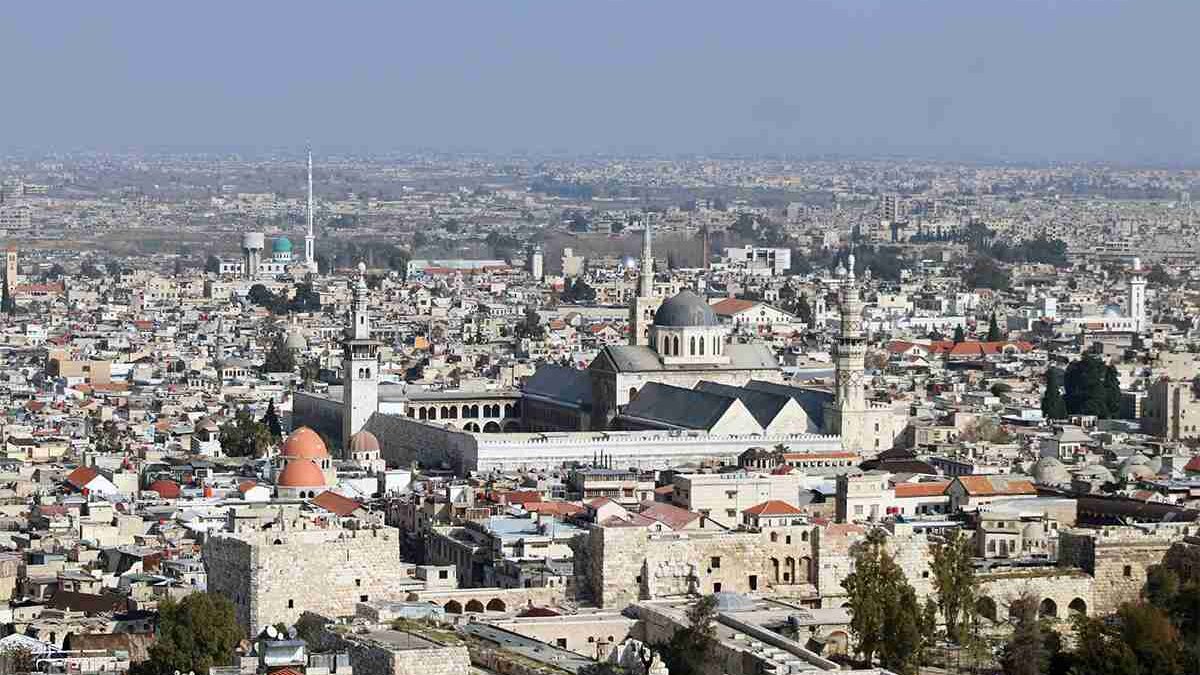
Damascus is often called the oldest continuously inhabited capital on earth, and it feels that way underfoot. Straight Street still holds the line of the Roman cardo; lanes turn into alleys that suddenly open to courtyards full of shade and water; the scent shifts from copper polish to jasmine to spice every few steps. What makes Damascus different is not a single landmark but the way everything lives together: a temple site becomes a church then a mosque; an Ottoman bazaar still carries the echo of caravan bells; a medieval bīmāristān seems designed by someone who cared how a patient breathes at noon. The Old City rewards walkers who slow down. You notice ablaq (striped) stone patterns that calm the eye, wooden mashrabiyas leaning toward the street like they want to chat, and workshop rhythms that never needed a microphone. Spend time here and the big story of Syria—trade, craft, faith, and everyday life sharing one tight space—tells itself without a signboard. (City fabric: no tickets posted for the district; practical details appear with individual sites below.)
Umayyad Mosque (Damascus)
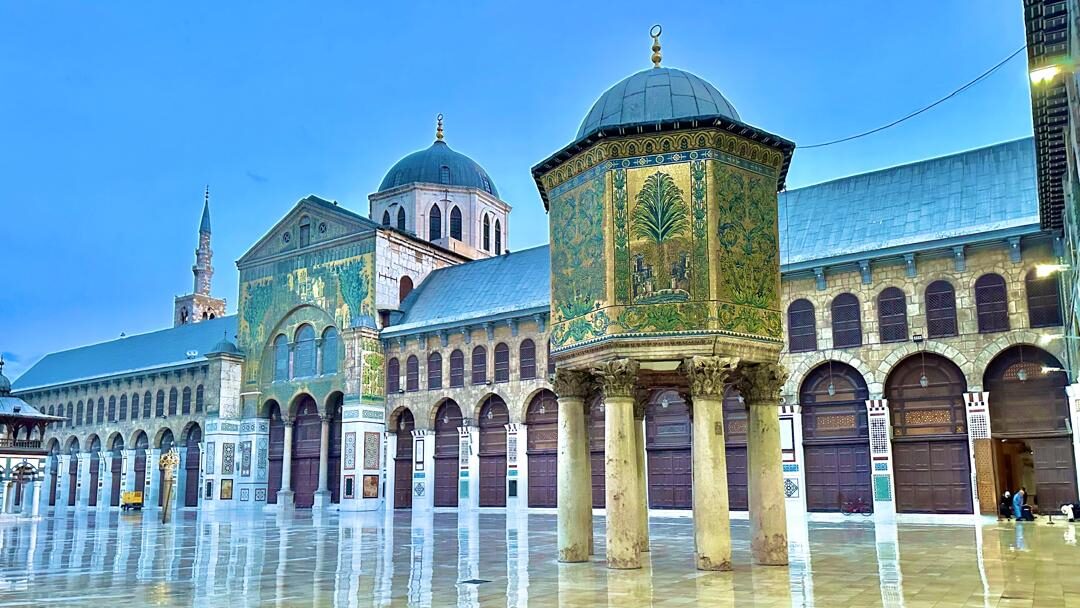
If you had to show a single place where Damascus holds three lives at once, it would be this courtyard. The ground began as a Roman temple precinct, then held a Byzantine basilica that kept the shrine of John the Baptist, and since the early 700s it has been one of the great mosques of the Islamic world. The beauty is not only architectural—the mosaics, arcades, and long prayer hall—but social: students, families, and pilgrims share the same cool marble and the same pockets of shade. Sit at the edge for five minutes and you watch the city breathe in and out. You can still sense the old role of the mosque as a learning core: a place where astronomy, medicine, and philosophy were part of normal conversation, not cold subjects in books. The building’s plan is a lesson in how to hold a crowd gently, and the way the light slides across the courtyard through the day is a small spectacle of its own.
Entrance Fee: 10,000 SYP (≈ $1)
Opening Hours: 09:00–21:00 daily (brief pauses during prayers)
What to expect: One of the world’s great mosques; access follows prayer times. Courtyards and interior spaces may close briefly during services.
Dress & conduct: Shoulders and knees covered; quiet voices in prayer halls.
Time needed: 30–60 minutes if key interiors are open.
Planning tip: We schedule around prayer times so you avoid waiting.
Damascus National Museum
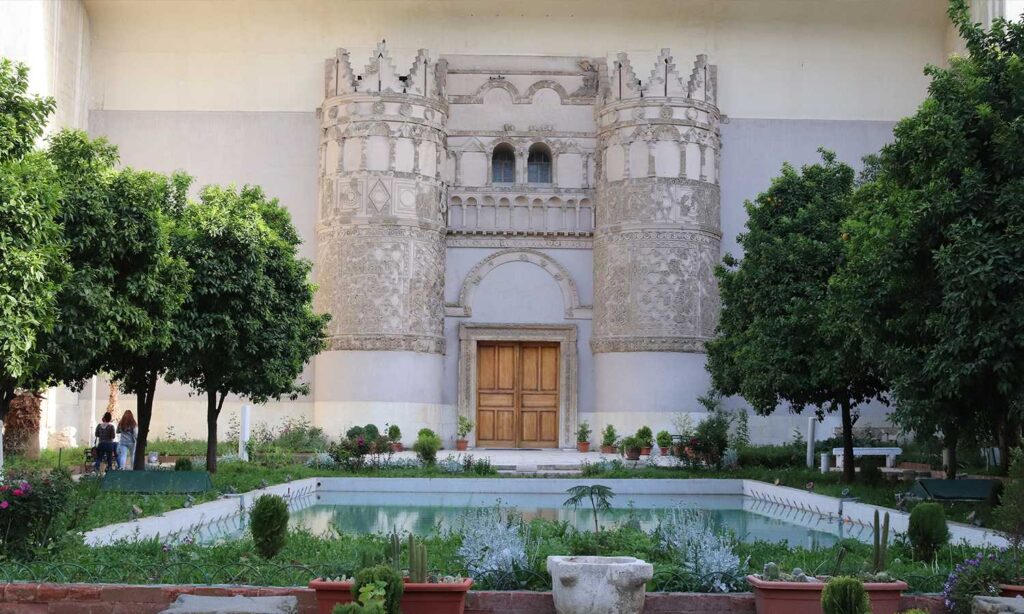
Call it one of the Middle East’s essential museums and you won’t be wrong. The Damascus collections run from prehistory through Islamic art, but what makes the place unforgettable are moments that feel like time travel: the fully reconstructed, wall-to-wall painted Dura-Europos Synagogue interior; the outdoor garden of stone with doorways and reliefs that still feel like they’re waiting for people; galleries that place you beside tablets and inscriptions with 5,000-year stories baked into them. The museum is the quickest way to understand Syria before you step into the country’s open-air “chapters.” Even the gate tells a story—the transplanted façade from the desert palace of Qasr al-Hayr al-Gharbi welcomes you like a prologue. Note for planners: the famous Ugaritic alphabet tablets and the Hurrian Hymn are part of the museum’s narrative but are not currently on display; the synagogue room easily fills that “showstopper” role on its own. Plan at least 90 minutes; two hours feels right if you like to read labels slowly.
Entrance Fee: 25,000 SYP (≈ $2.5)
Opening Hours: Summer 09:00–18:00; Winter 09:00–15:00; Friday closed
What to expect: Syria’s national collection across several galleries and courtyards. Security screening is standard and polite. Highlights cover archaeology, art, epigraphy, and daily life.
Time needed: 60–90 minutes for highlights; 2+ hours if you like to read panels.
Photography policy: Photography is not allowed inside. Respect the signs and staff instructions; outdoor courtyards may have different rules, but the default is no interior photography.
Practical tips: Mornings are calmer. Keep your ticket with you; a guard may check it near gallery doors.
Azm Palace (Qasr al-Azm, Damascus)
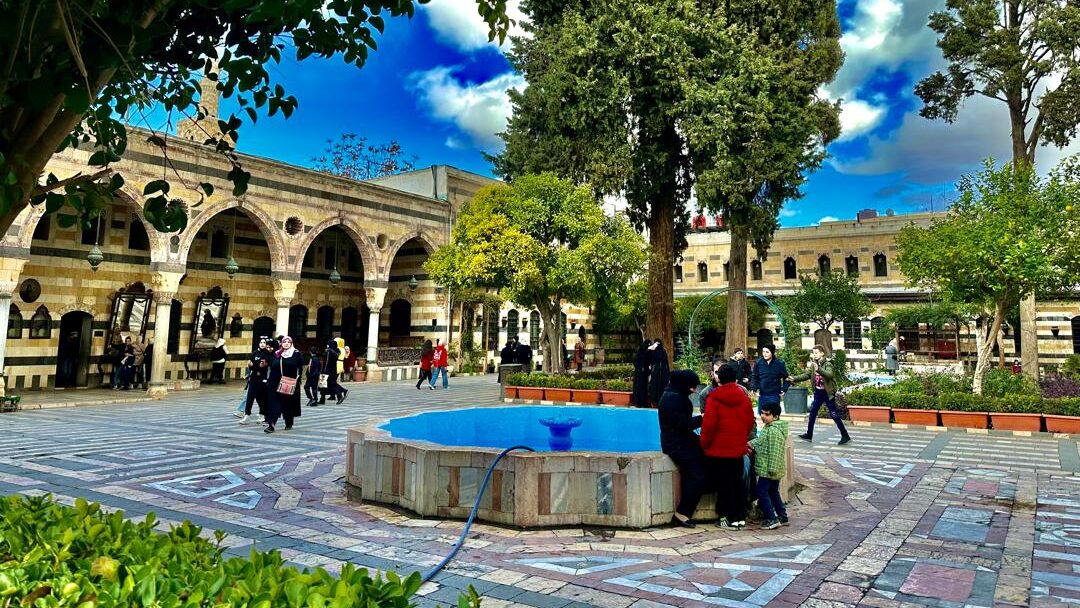
This 18th-century governor’s house is proof that true luxury in a hot city is shade, sound, and airflow. The design is clever without showing off: formal reception rooms close to the entrance for guests, quieter family rooms deeper inside, service tucked out of the way, and courtyards that cool simply by moving air and reflecting light. Ablaq stone calms the eye; painted ceilings lift it; fountains make a soft soundtrack that hides the outside world. Walk the sequence—from public to private—and you learn a lot about Damascene hospitality and hierarchy without a single paragraph of history. Rooms staged with period furniture make the daily life visible: how people ate, received, and rested. It’s one of those buildings that slows your heartbeat just by being in it. If you need to understand why everyone praises “Damascene houses,” come here and the idea will click in ten minutes.
Entrance Fee: 25,000 SYP (≈ $2.5)
Opening Hours: Summer 09:00–17:00; Winter 09:00–15:00; Tuesday closed
What to expect: A restored Damascene mansion with intimate courtyards and period rooms that illustrate domestic life.
Time needed: 45–75 minutes.
Best time for light: Morning light flatters the stone and wood.
Photography policy: Photography is not allowed inside the rooms. Enjoy the courtyards by eye and follow staff guidance.
Asaad Pasha Khan / Caravansarai (Khan Asʿad Pasha, Damascus)
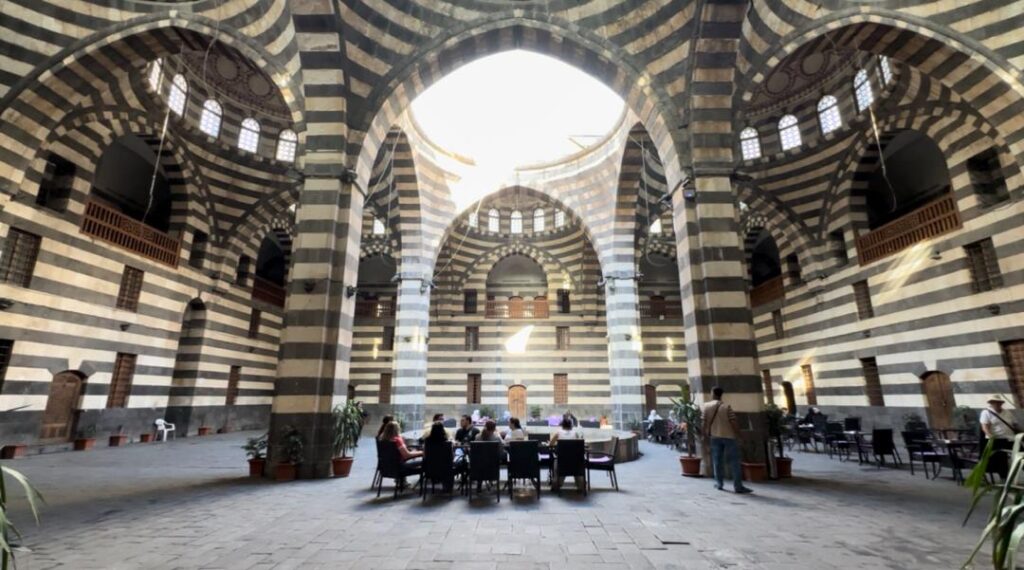
The great caravanserai of the Old City is a place to feel trade rather than read about it. Stand under the central dome and clap once: the echo answers you back, clean and exact. Merchants once slept on the galleries above while animals and goods stayed below, safe inside thick stone. The black-and-white geometry of the vaults, the coolness of the paving, and the steady proportions make even a short stop restorative after the bustle of the souqs. It’s architecture that works like medicine—five quiet minutes under those domes and your brain resets. Imagine the languages once spoken here in a single night: Arabic, Turkish, Armenian, Persian, Greek, Italian. That mix is part of why Damascus became Damascus.
Entrance Fee: 15,000 SYP (≈ $1.5)
Opening Hours: 09:00–15:30; Tuesday closed
What to expect: A grand, domed caravanserai at the heart of the old souqs—simple plan, atmospheric space.
Time needed: 20–40 minutes.
Combine with: Souq walk before or after; it’s a natural pause for a breather and photos of the exterior.
Bīmāristān Nūrī (Museum of Medicine & Science, Damascus)
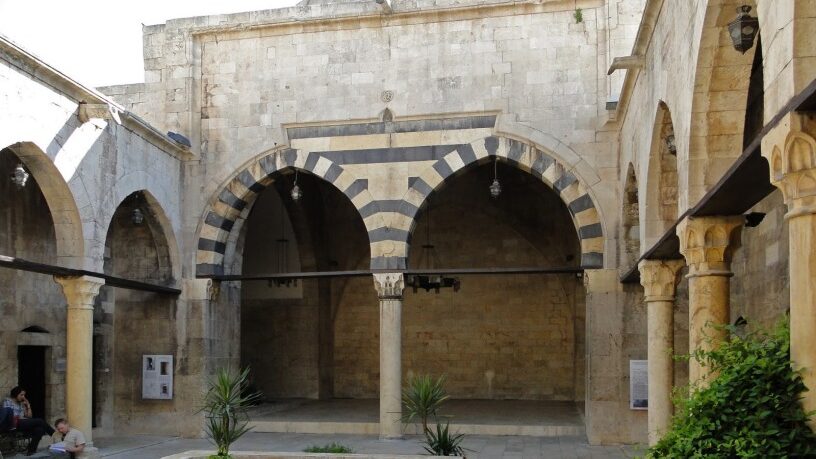
Hospitals in textbooks are numbers and dates; this one is courtyards and air. Founded in the 12th century by Nūr al-Dīn, it treated patients and trained physicians in spaces that still feel kind to the body: a quiet court for light and air, vaulted rooms that stay cool at noon, and a layout that respects sightlines and privacy. Walk through slowly and the medieval “curriculum” stops feeling distant—this is where medicine, pharmacy, and care of the soul overlapped. The museum displays are simple and human, more about experience than spectacle. If you enjoy places where you can sense how people actually lived and worked, this is a short, satisfying visit that pairs well with the palace and the khan.
Entrance Fee: 25,000 SYP (≈ $2.5)
Opening Hours: Summer 09:00–17:00; Winter 09:00–15:00; Tuesday closed
What to expect: A compact medieval hospital with courtyards, halls, and inscriptions.
Time needed: 20–40 minutes.
Note: A good “filler” between larger stops in the old city.
Old Damascus Living Heritage (Maktab Anbar, Beit Jabri, Nofara Café, Handicraft Lanes)

Some of Damascus’s best “sites” are still lived in. Maktab Anbar is a refined 19th-century mansion where light lands just right on carved wood and tile; it shows how a modernizing city kept its soul. Beit Jabri is a house-turned-café where lemon-mint and birdsong do as much for you as any museum label; you’ll understand why Damascenes love courtyards. Nofara Café, a step from the Umayyad precinct, sometimes hosts a hakawati—one storyteller, one chair, and a room held by voice alone. And in the handicraft lanes, coppersmiths, wood-inlay artists, weavers, and soap makers show the city’s oldest habit: turning raw stuff into beautiful, useful things. If you give any of these places thirty unhurried minutes, Damascus will end up feeling like a friend’s house, not just a chapter in a book.
Note: Maktab Anbar may post a small fee or “no fees collected at the moment
Opening Hours: daytime or late into evening depending on venue; workshops commonly 10:00–19:00.
Hejaz Railway Station (exterior)

You don’t need to be a train nerd to enjoy this Belle-Époque façade. The Hejaz Station was the proud Damascus gateway to a line that once ran deep into Arabia. Today the building serves administrative roles, but as a street-side stop it still delivers the romance of departures and returns. The clock, the ironwork, the long, low lines—everything says “movement,” even when the platforms are quiet. Bring a camera; the light here is kind in late afternoon.
Damascus Citadel — Closed

Even closed, the Ayyubid citadel makes sense of the city’s edge: it’s a castle pressed against a maze, a reminder that Damascus was valuable enough to guard closely. The massing of the walls and towers is the lesson—compact, no wasted lines, made to read from a distance. Worth a slow lap around the outside if you like fortification shapes.
Ticket: none (closed). Hours: n/a (exterior view only).
Tekkiye Suleimaniye — Closed for maintenance

Designed by the imperial architect Mimar Sinan, the Tekkiye complex wraps a calm courtyard with clean Ottoman geometry. Its serenity is the point: architecture that clears the mind without effort. Closed for now, but even a street view hints at the balance and proportion that made Sinan famous.
Ticket: none (closed). Hours: n/a.
Maʿlula & Saidnaya (Day Trip from Damascus)

Maʿlula is famous for cliffs that hold monasteries and for daily speech that still carries Western Aramaic—the language family of Jesus. Step into the chapels of Mar Sarkis (Saints Sergius & Bacchus) and Mar Taqla (Saint Thecla) and you feel a mountain town where faith and rock are one thing. The gorge walk is simple and beautiful. Saidnaya, one ridge away, centers on the Convent of Our Lady, a long-revered pilgrimage site with icons and wide views. These are places for quiet, not checklists: sit, listen to the breeze, and you’ll remember the visit longer.
Tickets: usually free/donation. Hours: daytime (some chapels close during services). Dress: modest.
Homs & Hama
Krak des Chevaliers — UNESCO World Heritage (near Homs)
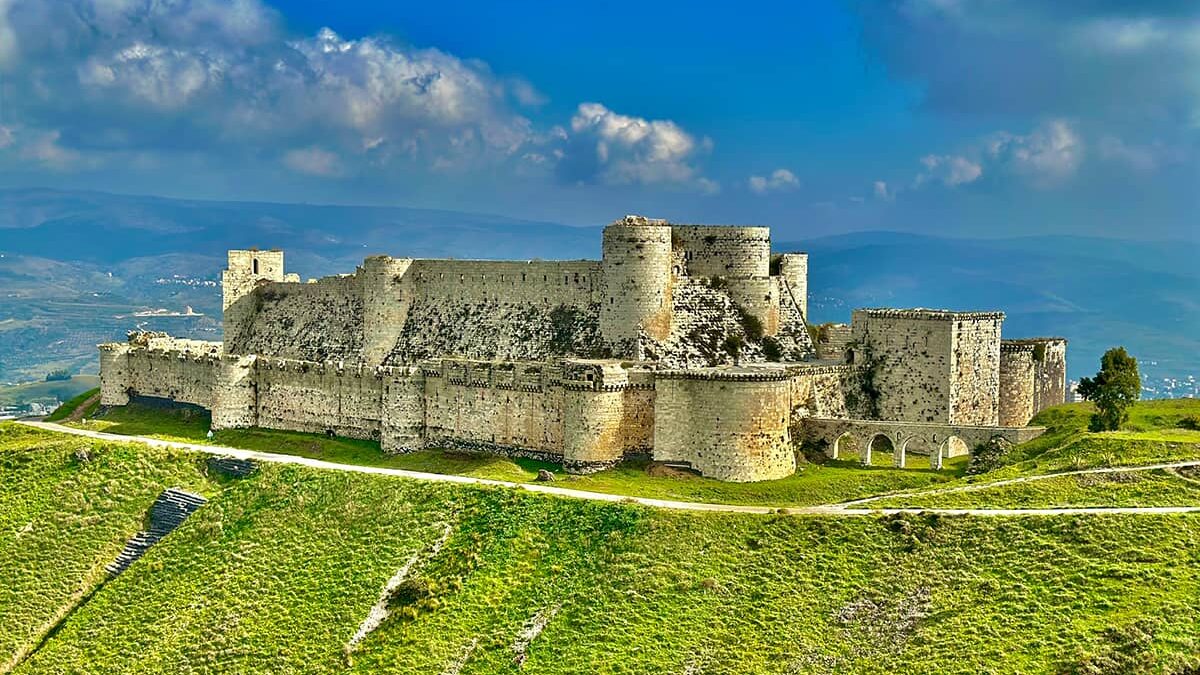
Krak is the castle that finally makes castles make sense. Concentric walls; watchful towers; a chapel; storerooms; ramps and passages that keep defenders fast and attackers slow—walk it and the logic appears step by step. The stone is honest and hugely confident; you can feel the builders knew they were making something that would last. Views roll for miles; the wind turns corners and surprises you; kids love the “secret” walks and arrow slits. Many travelers call it the best-preserved Crusader castle anywhere, and it’s hard to argue as you trace the lines of defense with your own feet. Take your time; this is a town in stone, not a single building.
Entrance Fee: 25,000 SYP (≈ $2.5)
Opening Hours: Daily; Summer 09:00–18:00; Winter 09:00–15:00
What to expect: A monumental Crusader fortress—walls, towers, chapel, outer works, and long views. Surfaces are uneven; towers involve steps.
Time needed: 90 minutes minimum; 2 hours is comfortable.
Safety note for heights: If you have a fear of heights, avoid the higher levels near edges—some sections have no fence. Choose central walkways and inner courtyards instead.
Timing tip: Arrive well before last entry; the approach road can be slow.
Hama Norias (Waterwheels)
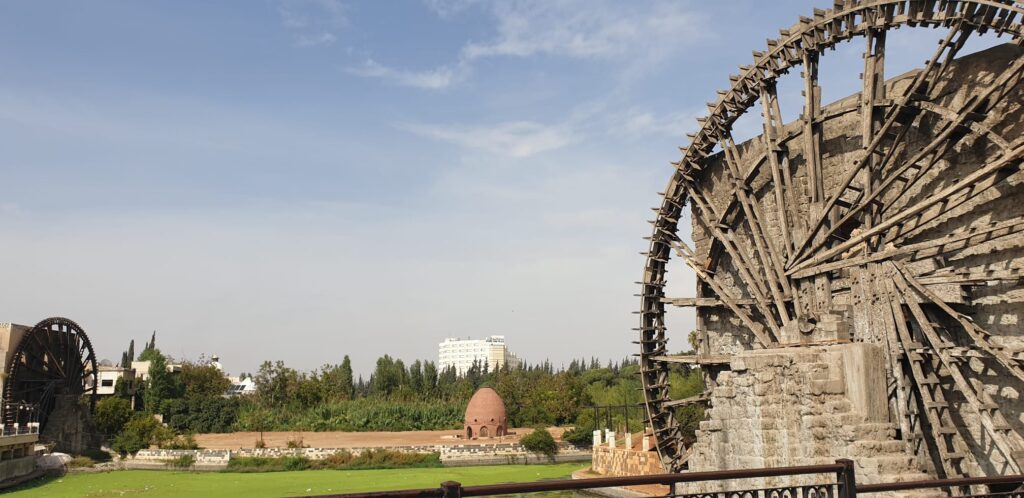
The norias are Syria’s softest machines. Giant wooden wheels lift river water into aqueducts, making a creak-and-splash rhythm that you’ll hear in your head long after you leave. Stand close and the scale is surprising; step back and the pattern becomes art. At sunset the wheels and water throw copper light over the river. They’re not only picturesque—they explain how a pre-modern city watered gardens, baths, and houses with patient, repeatable motion. You can pair the norias with a stroll along the river and a simple café stop; it’s one of the easiest, most enjoyable hours you’ll spend in the country.
Ticket: none (public riverfront). Hours: visible any time; late afternoon is best for light and sound.
Azm Palace (Hama)
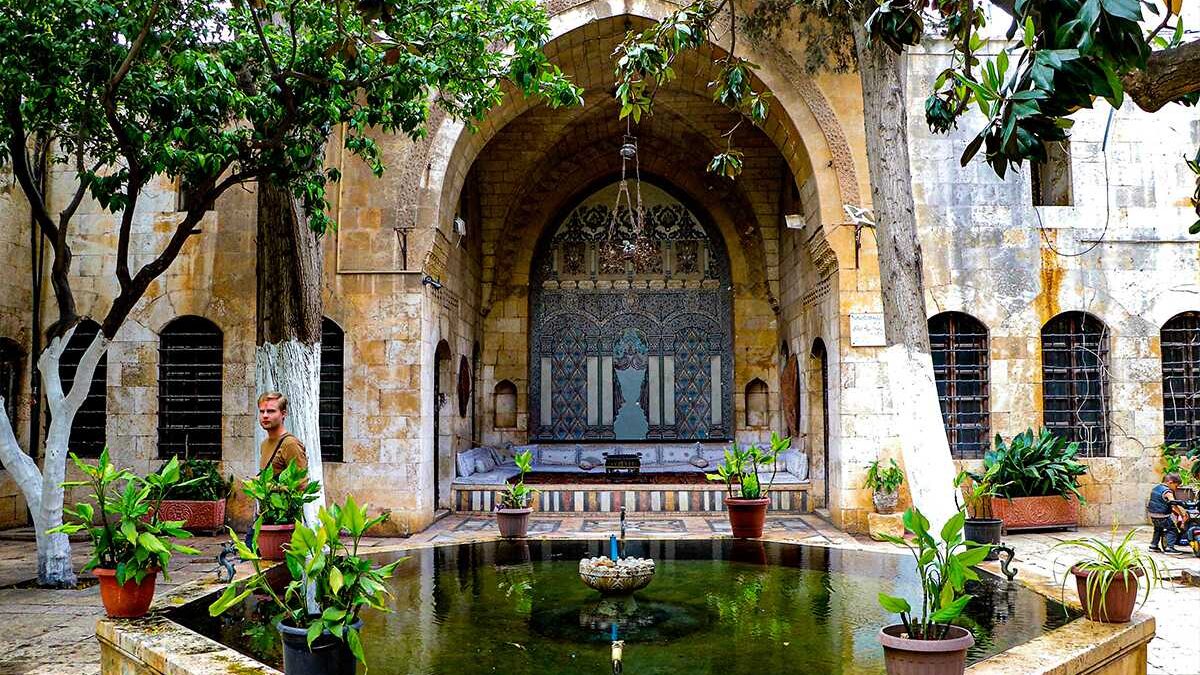
If Damascus shows you the grand version of a Damascene house, Hama gives you the gentler cousin. The palace is bright and airy, with fine woodwork and clear labels that make the story easy to follow. It’s a great place to understand provincial life: quieter hospitality rooms, smaller courts, and a rhythm that matches a smaller city. After the norias, this is the right kind of cool, shaded stop that invites a longer look at ceilings and doors. The staff are used to unhurried visitors—no rush, no crowds.
Entrance Fee: 15,000 SYP (≈ $1.5)
Opening Hours: Daytime pattern; winter commonly ~09:00–15:00; Tuesday closures are common
What to expect: A quieter palace with traditional rooms and local displays.
Time needed: 30–60 minutes.
Photography policy: Photography is not allowed inside the rooms.
Combine with: A walk to the norias (waterwheels) on the Orontes.
Khalid ibn al-Walid Mosque (Homs) & Virgin Mary Church of the Holy Belt (Homs)

Homs keeps two beloved landmarks close in memory. The Khalid ibn al-Walid Mosque, with its twin minarets and broad courtyard, holds the tomb of the famed commander inside a space that feels both open and intimate. Walk the arcade and you sense a city that still knows how to gather. A short drive away, the Church of the Holy Belt offers a quieter room with heavy stone and a long tradition tied to the “Holy Girdle.” The contrast—light Ottoman geometry versus deep, cool Christian stone—sums up how Syria’s cities hold different stories comfortably side by side.
Tickets: none. Hours: daytime; observe prayer/service times. Dress: modest for both.
Aleppo (UNESCO World Heritage)
Ancient City of Aleppo
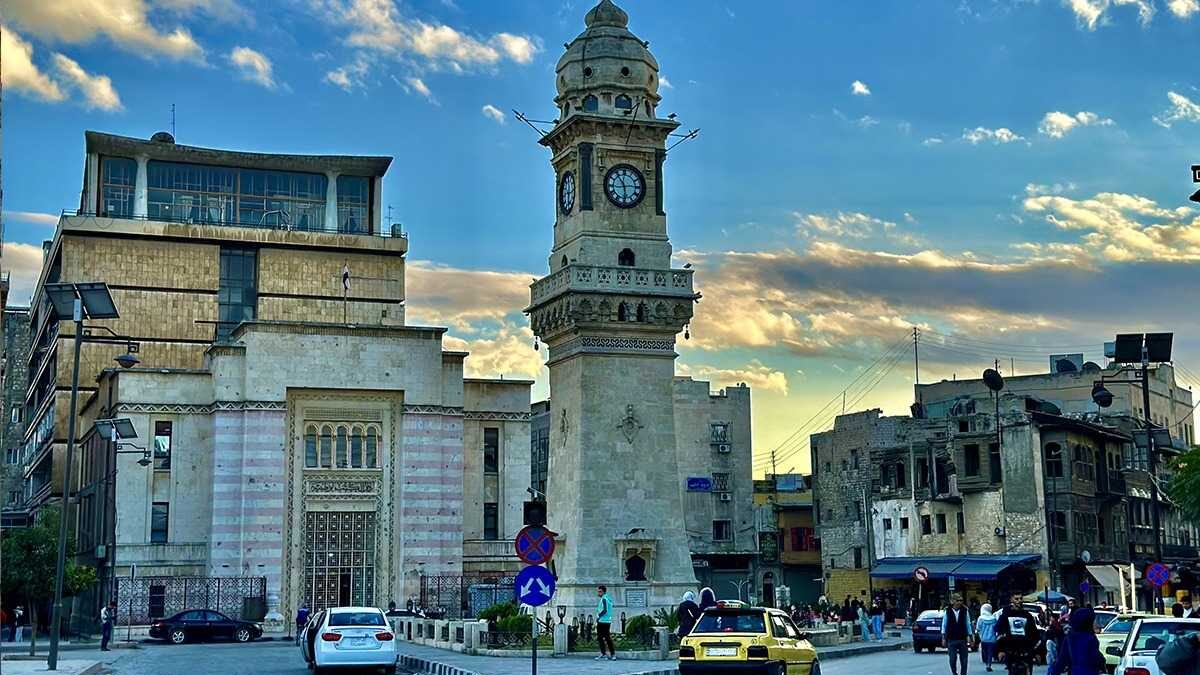
Aleppo is a city of hands. Bakers stack rounds of bread like coins; soap makers cut laurel-olive blocks into neat towers; metalworkers hammer a steady rhythm under vaults that hold the day’s cool. The Old City’s great suqs are coming back to life and the streets around the citadel are once again full of small, useful work. What makes Aleppo unforgettable is the way it uses stone to control sound and light—the markets hush the street, the alleys make shade, the courtyards collect air. History here is not a lesson; it’s a texture.
Citadel of Aleppo
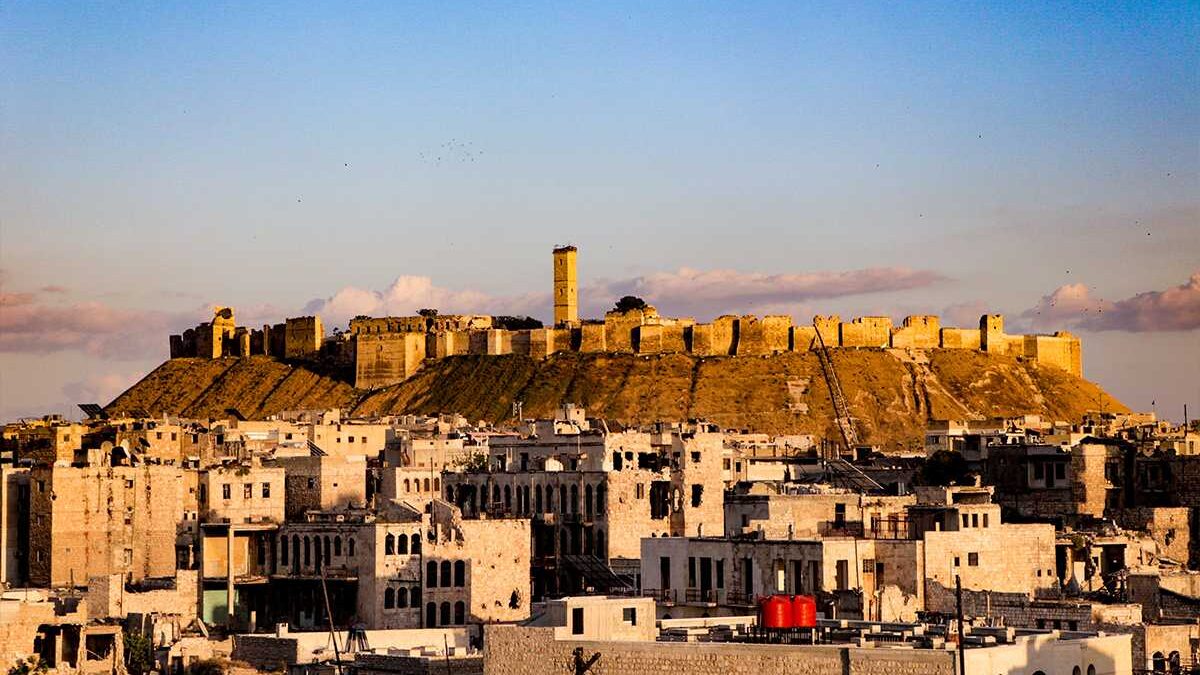
If Krak is a textbook in defense, Aleppo’s citadel is a theatrical entrance. The bridge rises and turns; the bent-axis gate forces anyone approaching to show a weaker side; towers look you in the eye as you climb. At the top, the city opens like a map. Inside are halls, a mosque, and rooms that appear like stage sets as you move, each with a slightly different mood. It’s one of those places where you understand power in your legs and lungs as much as in your eyes. Allow time to stop and look back down at the entrance path—the whole strategy is visible in one glance.
Entrance Fee: 50,000 SYP (≈ $5)
Opening Hours: Summer 09:00–18:00; Winter 09:00–15:00; Tuesday closed.
What to expect: A vast fortress on a high mound with a sequence of gates, ramps, courtyards, and interior rooms.
Time needed: 60–90 minutes for essentials; up to 2 hours if you stop often for photos.
Practical tip: Bring water. Expect stairs/ramps to reach the top.
Aleppo Museum

Aleppo Museum tells the story of northern Syria in one sweep. Its strength is deep time: a celebrated prehistoric gallery with material linked to the Dederiyeh Cave discoveries (including a Neanderthal child about 150,000 years old), and rich archaeology from the great Bronze-Age cities—Ebla, Mari, and Ugarit. Classical rooms once paired sculpture and inscriptions with mosaics from sites like Apamea, while later sections traced daily life through coins, glass, and crafts that made Aleppo a trading hub. The building itself is easy to navigate, with clear labels and space to breathe, so even first-time visitors can follow the timeline without effort. When it reopens, plan it as your first stop before the Citadel and the suqs: the context you pick up here makes the rest of the city click into place.
Price: 50,000 SYP (≈ $5)
Status: Closed at the moment, previously Summer 09:00–18:00; Winter 09:00–15:00; Tuesday closed.
Photography policy (when operating): Photography is not allowed inside. If the museum reopens during your dates, follow the posted notice and staff guidance.
Planning note: We’ll confirm status on the day if you’re in Aleppo.
Aleppo Souqs & Soap-Making

The covered markets of Aleppo once stretched for roughly ten to thirteen kilometers—a city beneath a city. Walk any section and you get the point: a cool, stone-roofed world made for buying, selling, and talking. Vaults collect the echoes; light falls in stripes; spices and leather smell the same as they did centuries ago. Add a soap factory visit and you see another Aleppo signature—laurel and olive oil cooked, poured, cut, stacked, and stamped by hand. It’s quiet theater and practical chemistry in one room, and it explains why a simple green brick became a global traveler. Even if you come for the citadel, you’ll leave remembering a craftsman’s gesture or a perfect stack of curing soap.
Tickets: none for souqs; soap visits often by arrangement (no ticket for a short look). Hours: typically 10:00–19:00 (later in summer).
Church of Saint Simeon Stylites (Qalʿat Simʿān) — UNESCO World Heritage (Ancient Villages of Northern Syria)

A 5th-century pilgrimage complex built around the column of a man who chose to live on top of it. The audacity of that story becomes architecture: four basilicas around a central crossing, arches that frame the sky, a hilltop where faith chose height and wind as companions. The ruins are large but readable; you don’t need a guide to feel why people came from far away to stand here. Look for the wear on thresholds and the view lines that push your eyes outward—this was designed to handle crowds and deliver awe gently.
Ticket: often 25,000 SYP when open. Hours: daytime; confirm locally.
The Limestone Massif “Dead Cities” — UNESCO World Heritage
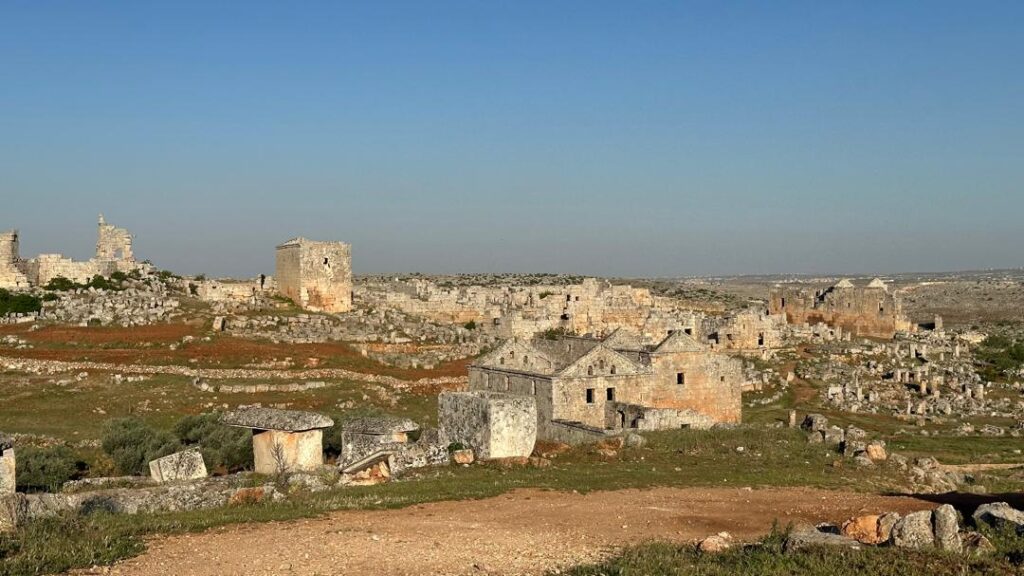
Serjilla, al-Bara, and their neighbors look like stone sketches of late-antique life: houses, olive presses, tombs, and churches left standing when trade routes shifted and people moved on. The villages are roofless but legible; the best part is the silence broken by birds and wind. You begin to understand everyday prosperity in Late Antiquity—places big enough to need basilicas, small enough to hear a goat bell across a field. Take your time; this landscape rewards slow walkers who like to notice a doorway or a press bed cut in living rock.
Tickets: vary by cluster; many have no fees collected at the moment. Hours: daytime; confirm locally.
Qalʿat Najm — Not accessible now
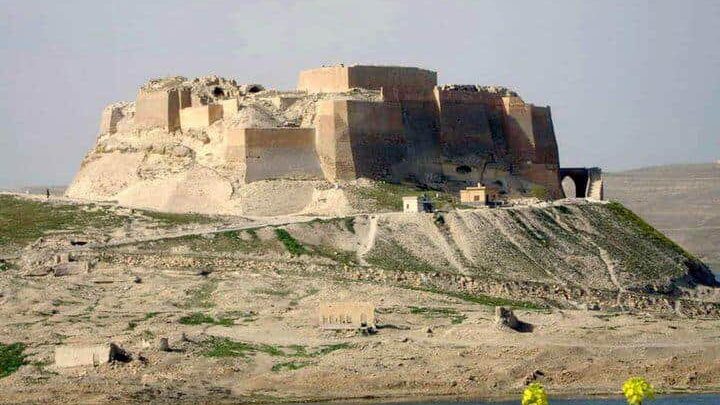
Perched above a shining bend of the Euphrates, Qalʿat Najm is one of Syria’s most picturesque fortresses. The plan is compact and the views are wide, but for now it’s a place to keep on your future list.
Ticket/Hours: no visitor access at present.
The Coast (Latakia & Tartus)
Qalʿat Ṣalāḥ al-Dīn (Saladin Citadel) — UNESCO World Heritage
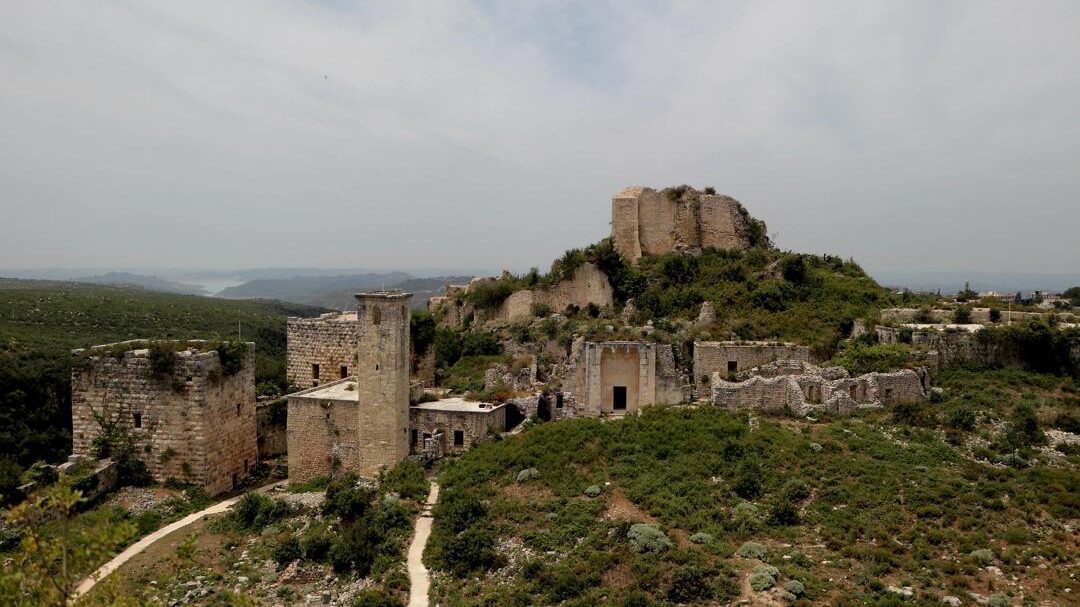
A fortress that turned a ridge into a weapon. The rock-cut moat is astonishing—an artificial canyon that isolates the inner stronghold as if nature did the work. Walls hug the spine of the hill; gates turn just when an attacker wants to breathe. The setting is green and airy, and the views feel like a reward handed out for thinking ahead. If you enjoy seeing strategy in stone, this is a must.
Price: 25,000 SYP (≈ $2.5)
Opening Hours: access can be restricted or by prior arrangement—confirm locally before you go.
What to expect: A ridge-top fortress with dramatic rock cuts and forested views.
Time needed: 60–90 minutes.
Comfort: Sloped paths and stairs; bring water, especially in warmer months.
Ugarit (Ras Shamra)

A low, wind-brushed ruin field that changed how we think about writing. Here, an early alphabetic script was used; here, scribes pressed music into clay. The site isn’t about big walls—it’s about the idea that letters and notes could travel faster because they were simpler to learn. Stand in a courtyard and imagine a harbor full of cargo and stories; Ugarit was an international address long before passports. It’s one of those places where a small sign—“house,” “palace,” “archive”—opens a door in your head.
Price: 25,000 SYP (≈ $2.5)
Opening Hours: Summer 09:00–18:00; Winter 09:00–15:00; Tuesday closed.
What to expect: The spacious palace of Ugarit with its special gate.
Time needed: 60–90 minutes.
Comfort: Sloped paths and thorns; wear long sleeves to avoid thorn scratches.
Arwad Island & Amrit (Phoenician Coast)
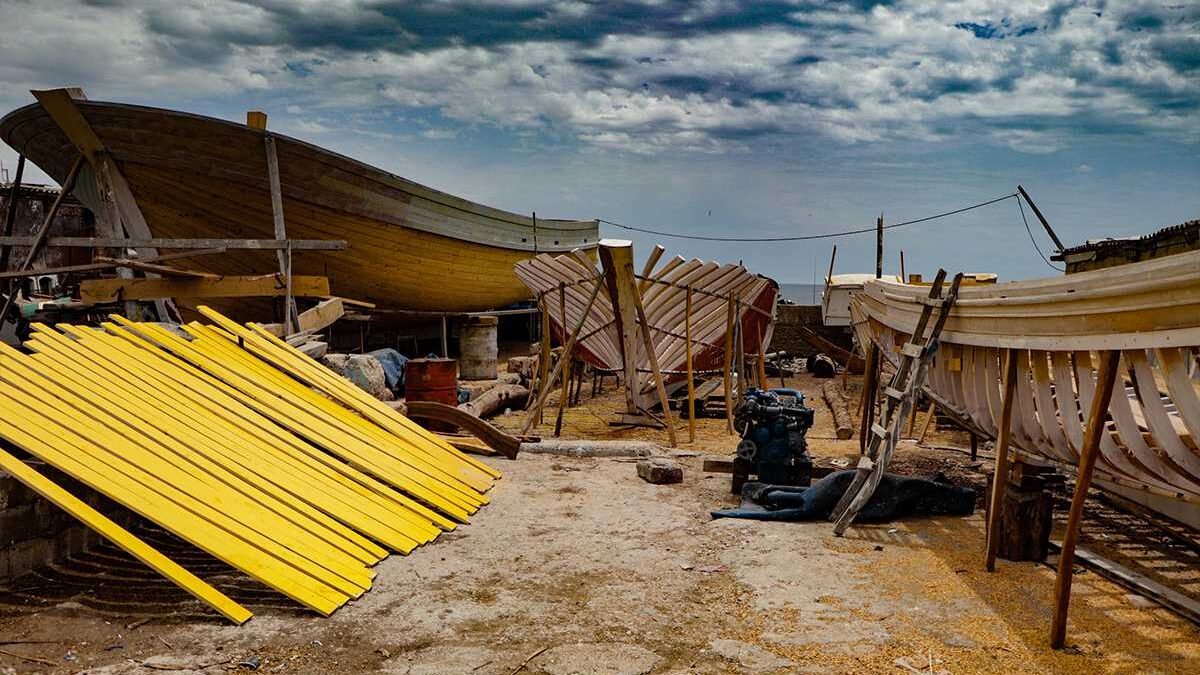
Arwad is Syria’s only inhabited island—lanes, boatyards, and sea light. The scale is human; the craft is traditional; it’s a short boat hop that gives you a different angle on the coast. South of Tartus, Amrit holds a rock-cut sanctuary and one of the world’s oldest sports grounds. You can stand at the edge of a hollow where crowds once roared without any barrier between you and the past. The two places together make a simple story: sailors’ work and sailors’ gods sharing the same piece of shore.
Tickets: Arwad has no site ticket (boat fare from Tartus applies). Amrit is often no fees collected at the moment. Hours: daytime; boat times vary by season and sea.
Marqab (Qalʿat Marqab) — Closed, but worth the view

A Hospitaller stronghold built of dark basalt that makes the sea look brighter by contrast. Even when interior visits are paused, the exterior is a show: massive angles, sharp profiles, and a café next to the fortress where coffee comes with a cliff-top panorama. If you’re driving the coast, a photo stop here earns its place in any itinerary.
Price: 25,000 SYP (≈ $2.5)
Status: Closed at the moment
What to expect now: You can still view the citadel from outside. There’s a café next to the citadel where you can sit for a tea or coffee overlooking the sea and the fortress. It’s a pleasant pause on a coastal route.
If/when open: Expect black-stone walls, steep sections, and spectacular coastal panoramas. Always follow the gate notice for access.
Jableh Roman Theater — Closed
Graceful seating cut to face the water, proportions that feel generous even empty—Jableh tells the story of a seaside Roman town that enjoyed good shows and better weather. For now, it’s a look-from-outside memory to collect and save for a future trip.
Ticket/Hours: closed (no access).
Cathedral of Our Lady of Tortosa (Tartus) — Closed
One of the best-preserved Crusader churches in the Levant, later adapted and used as the city museum. Its heavy lines and quiet courtyard turn noise into calm in a few steps. Closed at present, but an exterior walk still carries the weight of centuries.
Ticket/Hours: closed (no access).
The South (Hawran & Hauran)
Bosra (Ancient City) — UNESCO World Heritage
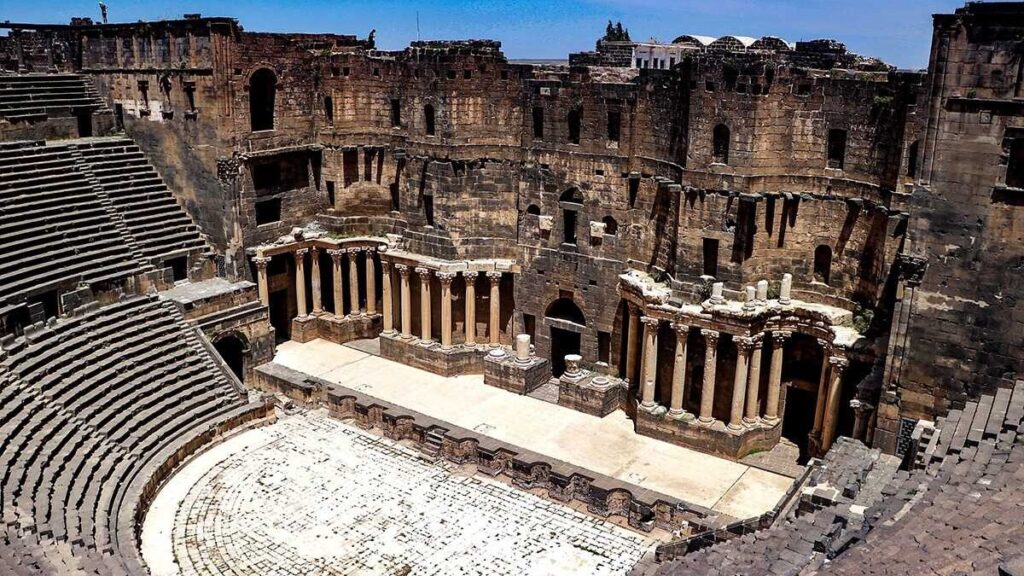
A black-basalt Roman city whose theater still feels ready for a performance. The stairs rise steeply, the stage buildings frame the sky, and acoustics test perfectly with a single word. What sets Bosra apart is not only preservation but setting: the theater sits within later walls, so you read centuries stacked, not erased. Wander the arcades and you get the sense of a place that worked—markets, baths, streets—rather than a ruin that only poses. If you love clear, bold Roman architecture, this might be your favorite stop in all of Syria.
Price: 25,000 SYP (≈ $2.5)
Hours: 09:00–17:00 daily. Access tip: ask for alternative entrances if you prefer to avoid steep descents.
What to expect: A remarkably preserved Roman theater with striking stone tiers and views from the upper levels.
Time needed: 45–75 minutes.
Stairs note: The main stairs are steep. If you are uncomfortable descending steep steps, use the other entrances that lead directly to the stage—staff can point out the easier routes.
Shahba (Philippopolis), Qanawat (Canatha) & Salkhad Castle
Three Hawran stops, three moods. Shahba is Emperor Philip the Arab’s vanity made practical: a Roman grid city where local mosaics sparkle with detail—myth beside daily life. Qanawat spreads temples, baths, and a small theater across countryside—black stone, open sky, and a pace that suits slow walkers. Salkhad climbs to a hilltop Druze fortress with views across a field of volcanic cones; on a clear day the landscape feels like a relief map. Together they show the Hawran’s strength: hardy stone, water sense, and straight-to-the-point building.
Tickets/Hours: often no fees collected at the moment; daytime access; confirm locally.
Central Syria & the Plains
Apamea (Afamia)
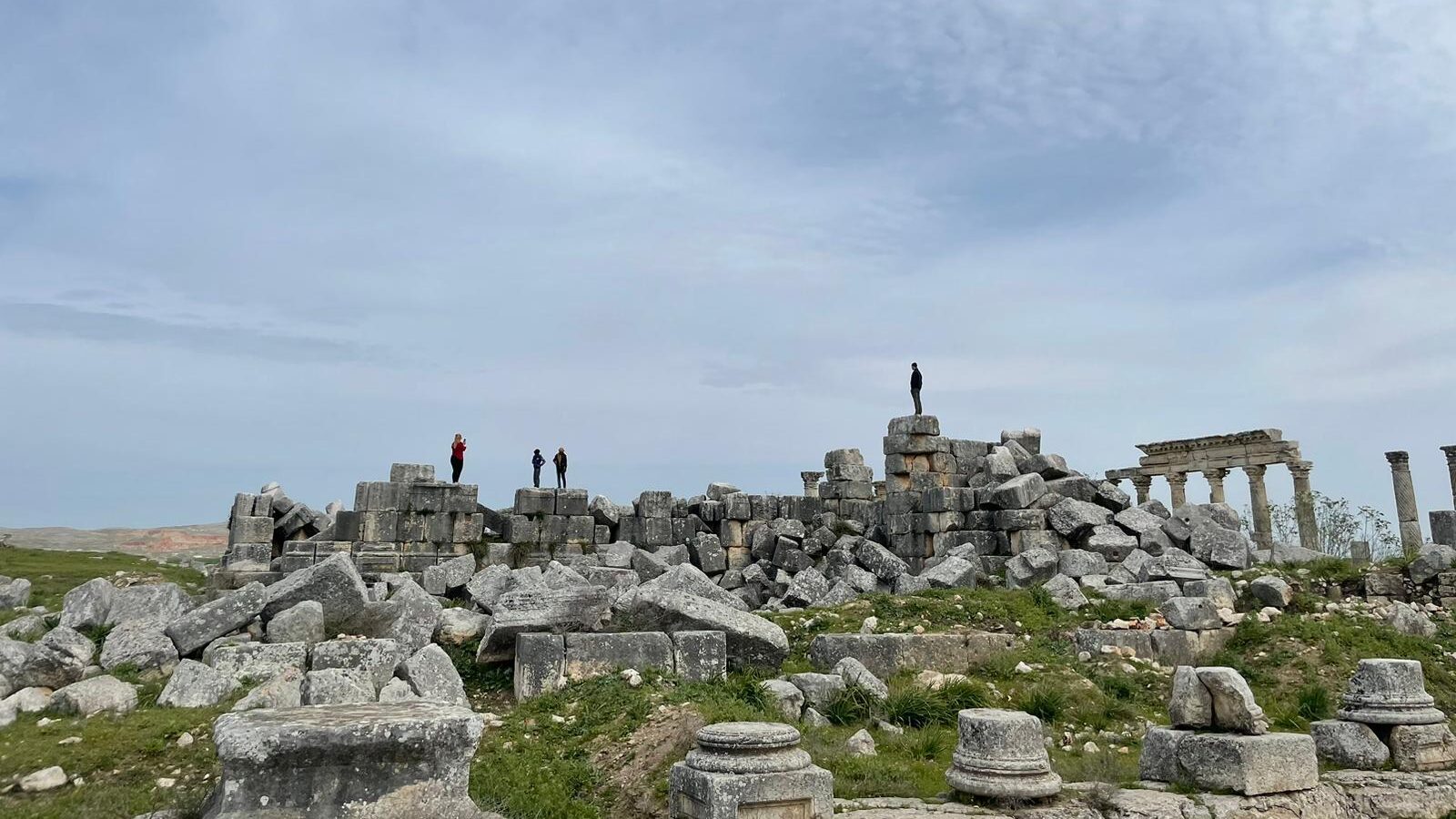
Apamea is the long walk: a nearly two-kilometer colonnaded avenue with distinctive spiral-fluted columns that make the street feel alive even roofless. The ridge setting means the wind has a voice here; the light changes minute by minute; wheel ruts and paving patches become the story if you let them. It’s the best place in Syria to understand the sheer scale of a classical city without a guidebook—just walk, stop, look back, and the urban plan reads itself. Many travelers call Apamea “the colonnade that doesn’t end,” and that’s exactly how it feels in good light.
Ticket: no fees collected at the moment. Hours: daytime; confirm locally before you drive out.
Misyaf Castle
An Ismaili stronghold famous in medieval chronicles, Misyaf rises directly above its town like a watchful neighbor. The masonry is sturdy and honest; passages and towers offer short surprises and quick views; you feel how messages and warnings would have moved through this place in minutes. It’s not grand like Krak; it’s practical—and that practicality is the charm. You come away with a sense of how smaller fortresses stitched together safety and authority across the hills.
Ticket: 25,000 SYP when open. Hours: daytime; confirm locally.
The Desert & the Euphrates
Palmyra (Tadmur) — UNESCO World Heritage

Palmyra is a city drawn with light. Colonnades set long lines against an open sky; tower tombs stand like punctuation marks on the desert’s sentence; the ruined temples still hold a little of the authority they once projected across caravan routes. Even with partial access, a sunrise or late-day walk shows why Palmyra lived so huge in travelers’ imaginations. This is where Syria’s role as connector—between empires, languages, and styles—feels obvious in the bones. Don’t rush; the empty space is part of the architecture.
Ticket: no fees collected at the moment (archaeological zone). Hours: sunrise–sunset in accessible sectors. Heat: very hot in summer—go early/late; take water, hat, sunscreen.
Palmyra Museum — Closed for maintenance
A compact museum that once tied site and story together—funerary reliefs with real faces, inscriptions that sound like voices, small objects that made the caravan city human. Closed now, but an easy second stop once it reopens.
Ticket/Hours: closed (no access).
Mari (Tell Hariri), Dura-Europos, and Halabiye–Zalabiye — Not accessible now
The Euphrates holds three deep chapters. Mari was a Bronze-Age royal city whose palace archives changed how scholars read early Syrian states. Dura-Europos, a frontier town on a cliff, preserved an early synagogue with painted walls and a Christian house-church—rare, early, vivid. Halabiye–Zalabiye (Zenobia) are twin fortified towns controlling a river bend; the landscape itself explains their purpose. For now, all three are for the notebook rather than the day plan—but they remain core to the story of Syria as a river civilization.
Ticket/Hours: no visitor access at present.
Qalʿat Jaʿabar & Raqqa — Off the map for now
Qalʿat Jaʿabar rises over Lake Assad with views that make photographers happy on clear days; Raqqa keeps the memory of an Abbasid capital with city walls and Qasr al-Banat. At the moment, neither belongs on a visitor route, but both matter in the country’s historical map.
Ticket/Hours: no visitor access at present.
Idlib Region (Bronze-Age Capitals & Mosaics)
Ebla (Tell Mardikh)
A Bronze-Age capital whose archives forced a rewrite of early Levant history. The site itself is low and wide—platforms, wall lines, and the sweep of a palace area—but it rewards imagination. This is where names in old tablets stopped being vague and turned into a network of real places with trade, diplomacy, and bureaucracy. Stand on the tell and picture scribes moving clay tablets that carried orders and receipts across a web that reached the coast and beyond. Ebla is proof that “ancient administration” was not a dusty idea but a living system.
Ticket: often no fees collected at the moment. Hours: daytime; confirm locally.
Maʿarrat al-Nuʿmān Mosaic Museum (Khan Murad Pasha)
A caravanserai turned museum filled—when operating—with large late-antique mosaics that show hunting, harvests, myths, and daily life. What makes these floors special is their human warmth: fishermen look tired in a real way; grape workers lean as if their backs mind the load; heroes and animals share panels without stiffness. The building itself, with long vaulted halls around a court, frames the stone pictures perfectly. Even if access is uneven, it remains one of the most beautiful mosaic stops in the region and a perfect partner to Apamea and Bosra in understanding how Romans and Byzantines pictured the world under their feet.
Ticket: no fees collected at the moment. Hours: confirm locally (access varies).
Sites where no fees are collected at the moment
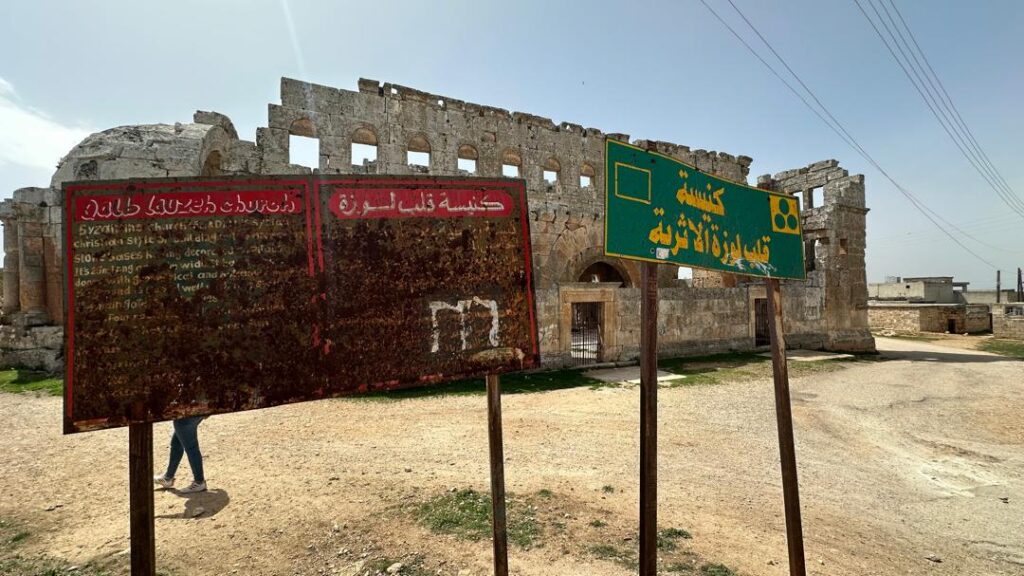
Palmyra (archaeological zone)
Current status: No fees collected at the moment
Climate note: Summer is very hot. Use sunscreen, wear a wide-brim hat, bring water, and avoid the midday peak if possible. Early morning or late afternoon is vastly more comfortable.
Access: Conditions can vary; we check before travel and adjust timing for heat and light.
Apamea (archaeological zone)
Current status: No fees collected at the moment
Planning note: Works or local conditions may affect access. Keep plans flexible and check the entrance board on the day.
Ma‘arrat al-Nu‘man Museum
Current status: No fees collected at the moment
Planning note: As with the others in this section, rely on the entrance notice for the latest situation.
Building a day around the current prices (simple examples)
These examples help independent travelers visualize time and cost. If you travel with us, remember your tickets are included, and we handle sequence and last-entry windows.
Damascus “heritage trio” (museum + palace + mosque)
- Damascus National Museum (25,000 SYP)
- Azm Palace (Damascus) (25,000 SYP)
- Umayyad Mosque (10,000 SYP)
Total tickets: 60,000 SYP (≈ $6)
Timing approach: Museum in the morning, palace late morning/early afternoon, mosque scheduled around prayer times. Optional add-on: Bimaristan Nuri (25,000 SYP).
Old City Damascus “architecture & souqs”
- Asaad Pasha Khan (15,000 SYP)
- Azm Palace (Damascus) (25,000 SYP)
- Bimaristan Nuri (25,000 SYP)
Total tickets: 65,000 SYP (≈ $6.5)
Timing approach: Caravanserai first (quieter souqs), then palace, then bimaristan; leave breathing room for the lanes and a coffee stop.
Coastal & castle day (north-west)
- Saladin Citadel (25,000 SYP)
- Krak des Chevaliers (25,000 SYP)
Total tickets: 50,000 SYP (≈ $5)
Timing approach: One site late morning, lunch break, second site mid-afternoon. Arrive well before last entry at the second site. If you pass Marqab Citadel while it’s closed, plan a sea-view coffee next to the fortress for a scenic pause.
Aleppo classic
- Aleppo Citadel (50,000 SYP)
Total tickets: 50,000 SYP (≈ $5)
Timing approach: Late morning or mid-afternoon balances light and heat; bring water.
Hama & south
- Azm Palace (Hama) (15,000 SYP)
- Busra Theater (25,000 SYP)
Total tickets: 40,000 SYP (≈ $4)
Timing approach: Usually split across different days or combined into a larger route. If same day, keep expectations simple and factor in driving time.
Practical comfort, etiquette, and small things that matter
- Hydration & sun: For citadels and open ruins, carry water. In summer—especially Palmyra—use sunscreen, a hat, and plan for early/late visits.
- Footwear: Expect uneven surfaces and steps at castles; closed, comfortable shoes are best.
- Photography etiquette: When a site forbids interior photos (e.g., Damascus National Museum, Aleppo Museum, Azm Palace in Damascus, Azm Palace in Hama), kindly keep cameras down indoors. Staff will appreciate it, and you’ll move through rooms more smoothly.
- Respect ropes and signs: They protect fragile floors, mosaics, and timber.
- Rubbish: If bins are missing, carry your rubbish until you find one; many courtyards are windswept and litter travels easily.
- Ask staff: Guards know which rooms open later and which doors are quicker—one friendly question can save you 10 minutes.
Simple copy-and-save price list (current)
- Damascus National Museum — 25,000 SYP (≈ $2.5) — No interior photography
- Azm Palace (Damascus) — 25,000 SYP (≈ $2.5) — No interior photography
- Asaad Pasha Khan / Caravansarai — 15,000 SYP (≈ $1.5)
- Bimaristan Nuri — 25,000 SYP (≈ $2.5)
- Umayyad Mosque — Visitor Ticket — 10,000 SYP (≈ $1)
- Krak des Chevaliers — 25,000 SYP (≈ $2.5) — Avoid unfenced high edges if you have a fear of heights
- Saladin Citadel (Latakia) — 25,000 SYP (≈ $2.5)
- Marqab Citadel (Tartus) — 25,000 SYP (≈ $2.5) — Closed; view from outside; café next to the citadel with sea views
- Aleppo Citadel — 50,000 SYP (≈ $5)
- Aleppo Museum — 50,000 SYP (≈ $5) — Closed; when operating, no interior photography
- Azm Palace (Hama) — 15,000 SYP (≈ $1.5) — No interior photography
- Busra Theater (Daraa/Busra) — 25,000 SYP (≈ $2.5) — Steep stairs; alternate entrances to the stage are available
- Palmyra (archaeological zone) — No fees collected at the moment — Very hot in summer; sunscreen, hat, water; avoid midday
- Apamea (archaeological zone) — No fees collected at the moment
- Ma‘arrat al-Nu‘man Museum — No fees collected at the moment
Travel with us: entrance fees included, day paced for comfort
On our private tours and group tours, all entrance fees are included. We time each stop to avoid last-entry cut-offs, handle tickets, and keep the walking comfortable so you can focus on the experience. If a place is not collecting fees at the moment, we verify access the same day and brief you before we go.
If you already have a wish-list—two days in Damascus, an Aleppo overnight, a castles day up north—share it with us. We’ll confirm the timing, parking points, walking distances, and where a coffee stop makes sense (like the café by Marqab with its sea view) so your day flows naturally.
Final reminders before you go
- Carry SYP cash.
- Arrive well before last entry (often 30–60 min before closing).
- Read the gate notice for final hours and any temporary changes.
- Dress modestly for mosques; choose comfortable shoes for citadels.
- Follow photography rules—especially no interior photos where posted.
- With us, tickets are included—you enjoy the sites while we handle the logistics.
